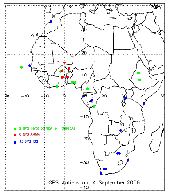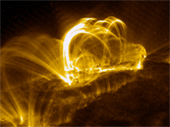
| Solar News --2007--
December 14, 2007 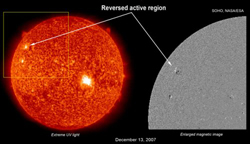
Is a New Solar Cycle Beginning? (NASA Feature) The solar physics community is abuzz this week. No, there haven't been any great eruptions or solar storms. The source of the excitement is a modest knot of magnetism that popped over the sun's eastern limb on Dec. 11th, pictured below in a pair of images from the orbiting Solar and Heliospheric Observatory (SOHO). It may not look like much, but "this patch of magnetism could be a sign of the next solar cycle," says solar physicist David Hathaway of the Marshall Space Flight Center Image Credit: SOHO (ESA & NASA) December 6, 2007 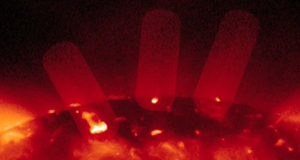
The Sun is Bristling with X-ray Jets (NASA Feature) Astronomers using Japan's Hinode spacecraft have discovered that the sun is bristling with powerful "X-ray jets." They spray out of the sun's surface hundreds of times a day, launching blobs of hot gas as wide as North America at a top speed of two million miles per hour. These jets add significant mass to the solar wind and they may help explain a long-standing mystery of astrophysics: the superheating of the sun's corona. Image Credits: JAXA November
13, 2007 Something strange is happening in the atmosphere above Africa and researchers have converged on Addis Ababa, Ethiopia, to discuss the phenomenon. The Africa Space Weather Workshop kicked off Nov. 12th with nearly 100 scientists and students in attendance. The strange phenomenon that brings all these people together is the ion plume—"a newly discovered form of space weather," says University of Colorado atmospheric scientist and Workshop co-organizer Tim Fuller-Rowell.
October
1, 2007
Image
Credit: NASA
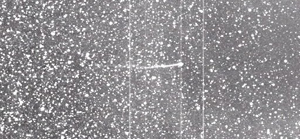 The Sun Rips Off a Comet's Tail (NASA Feature) Comet Encke never knew what hit it. On April 20, 2007, the comet had just dipped inside the orbit of Mercury, perilously close to the sun, when a solar eruption struck and literally tore the comet's tail off. This surely has happened to comets before, but for the first time in history a spacecraft was watching. NASA's STEREO-A probe recorded a fantastic movie of the collision.
September
26, 2007 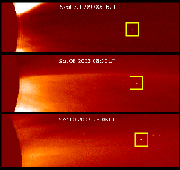
SOHO Mission Discovers Rare Comet (NASA Feature) The Solar and Heliospheric Observatory (SOHO) has discovered a rare periodic comet. SOHO has already discovered more than 1,350 comets during its mission, but this is the first time one of its discoveries officially has been designated periodic. Image Credit: ESA/NASA
September
18, 2007
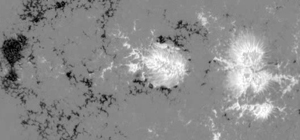
Magnetic Trilobite (NASA Feature) "We've never seen anything quite like it," says solar physicist Lika Guhathakurta from NASA headquarters.Last week she sat in an audience of nearly two hundred colleagues at the "Living with a Star" workshop in Boulder, Colorado, and watched in amazement as Saku Tsuneta of Japan played a movie of sunspot 10926 breaking through the turbulent surface of the sun. Before their very eyes an object as big as a planet materialized, and no one was prepared for the form it took. Image credit: JAXA September 14, 2007 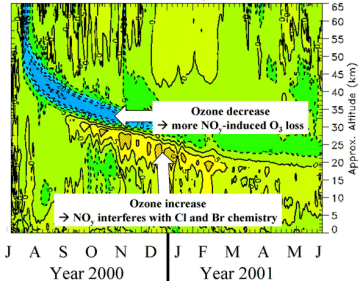
Noxious Activity (SpaceWeather.com) Scientists attending the Living With a Star workshop in Boulder, Colorado, learned yesterday that solar storms can have long-lasting effects on Earth's ozone layer. Charles Jackman of the Goddard Space Flight Center reported that solar protons hitting Earth in July 2000 altered the chemistry of the upper atmosphere, resulting in "huge enhancements (>100%) in middle stratospheric NOx." July
10, 2007 A
new scientific study concludes that changes in the Sun's output
cannot be causing modern-day climate change. It shows that for
the last 20 years, the Sun's output has declined, yet temperatures
on Earth have risen.
It also shows that modern temperatures are not determined by the
Sun's effect on cosmic rays, as has been claimed. More information about solar variability and global warming:
Image Credit: NASA/LMSAL
June
21, 2007 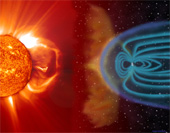 ASU Geophysicists Detect Molten Rock Layer Deep Below American Southwest (ASU Insight) A
sheet of molten rock roughly 10 miles thick spreads underneath
much of the American Southwest, some 250 miles below Tucson. From
the surface, you can't see it, smell it or feel it. Image Credit: NASA-MSFC
June
19, 2007
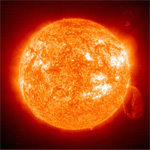 Mysteries of Light (Washington Post) For
Centuries, Man Has Yearned to Understand the Power of the Sun.
Now Area Scientists Are Working to Harness It. Image Credit: SOHO (ESA & NASA)
May
29, 2007 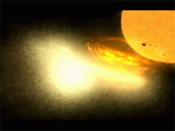 Screaming CMEs Warn of Radiation Storms (NASA Feature) A CME (Coronal Mass Ejection) is a solar body slam to our high-tech civilization. CMEs begin when the sun launches a billion tons of electrically conducting gas (plasma) into space at millions of miles per hour. A CME cloud is laced with magnetic fields, and CMEs directed our way smash into Earth's magnetic field. Image
Credit: NASA
May
25, 2007 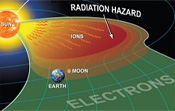 A Breakthrough in Solar Storm Forecasting (NASA Feature) A scientist using the Solar and Heliospheric Observatory (SOHO) has found a way to forecast solar radiation storms. The new method offers as much as one hour advance warning, giving astronauts time to seek shelter and ground controllers time to safeguard their satellites when a storm is approaching. Image
Credit: Science@NASA
May
10, 2007
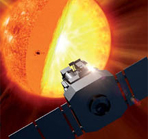 Get Ready to Explore the Heart of the Sun (SOHO Mission News) Scientists may have at last found a way to explore the heart of the sun with the detection of a special type of wave generated deep in the solar interior. The heart, or core, of the sun is the location of the sun's nuclear furnace, where fusion reactions power the sunlight that supports almost all life on Earth. Image Credit: ESA and NASA April 26, 2007 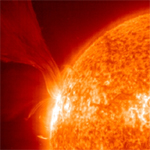 Solar peak expected in 2011-2012 (CNN.com) Scientists are predicting the next solar cycle will peak in 2011 or 2012. Increased solar activity may disrupt the Global Positioning System, airlines, and satellites. Image Credit: SOHO (ESA & NASA) April 25, 2007 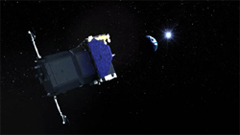 The Quest to Predict the Next Space "Hurricane" Season (NASA Feature) Violent solar events, like flares and coronal mass ejections, are the hurricanes of space weather, capable of causing havoc with satellites, power grids, and radio communication, including the Global Positioning System. Image Credit: NASA April 24, 2007 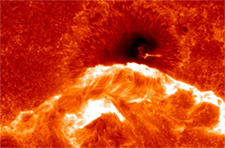 A Massive Explosion on the Sun (NASA Feature) Astronomers are calling the Japanese Hinode spacecraft a "Hubble for the sun." Watch this movie and you'll see why. The footage, gathered by Hinode's Solar Optical Telescope (SOT) on Dec. 13, 2006, shows sunspot 930 unleashing a powerful X-class solar flare. Image Credit: NASA April 23, 2007 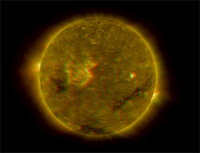 STEREO Sees the Sun in Three Dimensions (NASA Press Release) NASA's twin Solar Terrestrial Relations Observatory (STEREO) spacecraft have made the first three-dimensional images of the sun. The new view will greatly aid scientists’ ability to understand solar physics and thereby improve space weather forecasting. More Links: STEREO
Website Image Credit: NASA/STEREO April 19, 2007 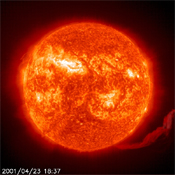
Sun's Atmosphere Sings Astronomers have recorded heavenly music bellowed out by the Sun's atmosphere. Snagging orchestra seats for this solar symphony would be fruitless, however, as the frequency of the sound waves is below the human hearing threshold. While humans can make out sounds between 20 and 20,000 hertz, the solar sound waves are on the order of milli-hertz--a thousandth of a hertz. Image Credit: SOHO (ESA & NASA) April 4, 2007 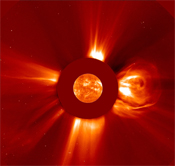 Solar bursts may threaten GPS (USA Today) Image Credit: NASA
March
21, 2007  New Phenomena on the Sun (NASA Feature) NASA has just released never-before-seen movies of intense activity in an unexpected place on the sun. The images were captured by a space telescope onboard Japan's Hinode spacecraft.
March
12, 2007  Stereo Eclipse (NASA Feature) No human has ever witnessed a solar eclipse quite like this: NASA's STEREO-B spacecraft was about a million miles from Earth last month when it photographed the Moon passing in front of the sun. The resulting movie looks like it came from an alien solar system. Image
Credit: NASA/STEREO
March
5, 2007 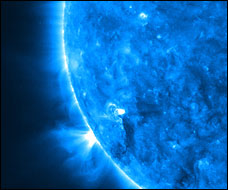
'Space Weather' Forecasting Gets a Cosmic Boost (Washington Post) Weather forecasting just isn't what it used to be. Image
Credit: NASA/NRL
March
3, 2007 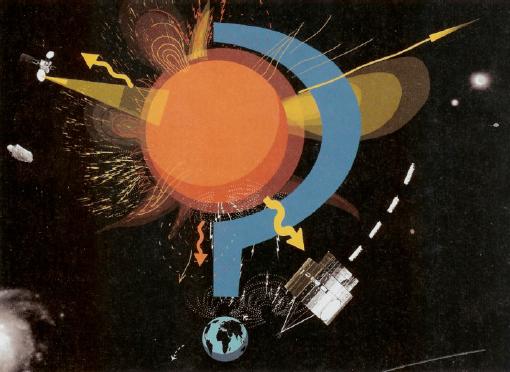 Batten Down the Hatches, Solar Flare Headed This Way (New Scientist) Reliable forecasting will ensure that solar storms no longer wreak havoc here on Earth. That’s right! The Moon is the central figure in two different kinds of eclipses within one week. Video Clip: Lunar transit of the sun seen from STEREO Image Credit: NASA
The oldest solar observatory in the Americas has been discovered in coastal Peru, archeologists announced today. February 22, 2007  No Safe Place The ESA-NASA Ulysses spacecraft has discovered that there is no place in the inner solar system completely safe from solar radiation storms. Image
Credit: NOAA
February 20, 2007  A Cool Solar Mystery One pole of the sun is cooler than the other. That's the surprising conclusion announced today by scientists who have been analyzing data from the ESA-NASA Ulysses spacecraft. Image
Credit: ESA
February 7, 2007  South Pole Flyby (NASA Feature) Less than one hundred years ago, the south pole of Earth was a land of utter mystery. Explorers labored mightily to get there, fighting scurvy, wind, disorientation and a fantastic almost-martian cold. Until Roald Amundsen and Robert F. Scott reached the Pole in 1911 and 1912, it was terra incognita. The
situation is much the same today—on the sun. See Also: NASA-European Spacecraft Swoops Under Sun's Pole (NASA News: Exploring the Universe) Image
Credit:
NASA/JPL. |
